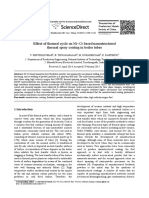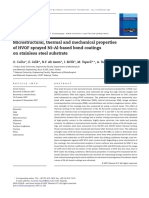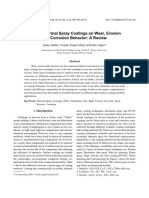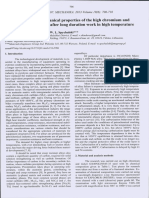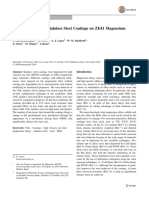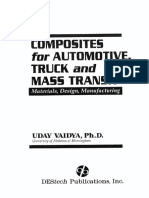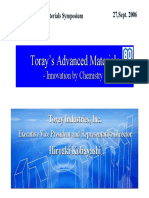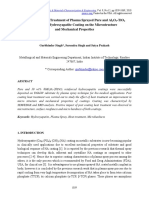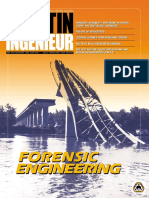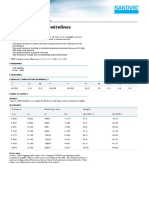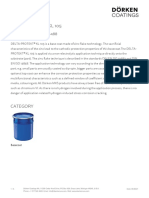Effect of Post-Heat Treatment On The Corrosion Resistance of Niwcrbsi Hvof Coatings in Chloride Solution
Effect of Post-Heat Treatment On The Corrosion Resistance of Niwcrbsi Hvof Coatings in Chloride Solution
Uploaded by
Victor Daniel WaasCopyright:
Available Formats
Effect of Post-Heat Treatment On The Corrosion Resistance of Niwcrbsi Hvof Coatings in Chloride Solution
Effect of Post-Heat Treatment On The Corrosion Resistance of Niwcrbsi Hvof Coatings in Chloride Solution
Uploaded by
Victor Daniel WaasOriginal Title
Copyright
Available Formats
Share this document
Did you find this document useful?
Is this content inappropriate?
Copyright:
Available Formats
Effect of Post-Heat Treatment On The Corrosion Resistance of Niwcrbsi Hvof Coatings in Chloride Solution
Effect of Post-Heat Treatment On The Corrosion Resistance of Niwcrbsi Hvof Coatings in Chloride Solution
Uploaded by
Victor Daniel WaasCopyright:
Available Formats
JTTEE5 11:95-99
© ASM International
Effect of Post-Heat Treatment on the
Peer Reviewed
Corrosion Resistance of NiWCrBSi
HVOF Coatings in Chloride Solution
L. Gil, M.A. Prato, and M.H. Staia
(Received 21 June 2000; in revised form 22 November 2000)
High velocity oxygen fuel (HVOF) thermal spray is one of the most versatile and fastest techniques used to
apply wear- and corrosion-resistant coatings to critical component surfaces. In such applications where the
material is submitted to a corrosive environment, coating porosity is one of the most important microstruc-
tural aspects determining the performance of the material. In the present work, the results regarding the
effect of both carburizing flame and argon atmosphere post-heat treatments on the microstructure and
corrosion resistance of NiCrWBSi coatings are reported. Both microstructural characterization and poros-
ity determination were carried out before and after the heat treatments. It was determined that both treat-
ments had reduced the porosity considerably, and this reduction was accompanied by pronounced micro-
structural changes regarding the disappearance of the initial lamellar structure, a more uniform distribution
of the hard phases, and a decrease in the number of microcracks and unmelted particles. Results from
potentiodynamic studies carried out in a 5% NaCl solution have indicated an increase in the corrosion
resistance of both heat-treated coatings.
Keywords corrosion, HVOF, Ni-based coating, post-heat treat- preventing the contact between the corrosive liquids and the sub-
ment strate.
Nickel-based alloys, which incorporate fine hard phases such
as borides, carbides, and carboborides distributed uniformly
1. Introduction thorough the Ni-Cr-B matrix, have performed successfully
against abrasion wear,[1,2] but both the porosity and the moderate
Coatings obtained by thermal spray technology are widely adhesion of the coating are the main concerns when corrosion
used in many industrial applications where abrasion wear and resistance is required.
corrosion resistances are required. Because of inherent process- Therefore, the present work was performed with the aim of
ing characteristics, thermal spray coatings present microporos- determining the influence of the post-heat treatment on the cor-
ity, microcracks, oxides, and unmelted particles which influence rosion behavior and microstructure of an HVOF nickel-based
the mechanical properties and seriously compromise their cor- alloy.
rosion resistance in a given environment.[1-3]
Several studies[4,5] have demonstrated that coating porosity
2. Experimental Procedure
acts like a crevice, inducing crevice corrosion, and that severe
galvanic corrosion will occur if the electrolyte reaches the sub-
HVOF was carried out using a Hobart Tafa JP-5000 (USA)
strate for coatings that are nobler (i.e., cathodic to the substrate).
gun on an AISI 1020 substrate. The substrate material was grit
Although the development of higher velocity processes (e.g.,
blasted by using angular chilled iron prior to thermal spraying.
high velocity oxygen fuel [HVOF] and D-Gun) has contributed
The nominal composition of the commercial NiWCrBSi alloy is
to a decrease in the coating porosity, the transport of the corro-
presented in Table 1.
sive species could only be impeded by different post-treatments
The nickel-based alloy powders employed had a particle size
that can be applied to the as-deposited coatings. Different tech-
range of 22 to 63 µm[3] and presented an equivalent diameter of
niques such as flame, plasma jet, laser, isostatic hot pressing, and
31.45 µm. Table 2 summarizes the deposition conditions for
atmospheric and vacuum furnace heating[1,2,4,6-9] have been suc-
HVOF. The final coating thickness for all samples was con-
cessfully applied. Impregnation methods[10] also could be an al-
trolled to be 0.3 mm.
ternative in diminishing the amount of the reactive surface and
The as-deposited samples were post-heat treated by using
L. Gil, Department of Metallurgical Engineering, National Polytechnic
University (UNEXPO), Puerto Ordaz, Estado Bolivar, Venezuela; Table 1 Nominal Composition of Nickel Alloy
M.A. Prato, School of Mechanical Engineering, Central University of (Colmonoy 88)
Venezuela, Caracas, Venezuela; and M.H. Staia, School of Metallur-
gical Engineering and Materials Science, Central University of Venezu- W Cr B Fe Si C Ni
ela, Apartado 49141, Caracas 1042-A, Venezuela. Contact e-mail: wt.% 17.00 15.00 3.00 3.50 4.00 0.75 Balance
mstaia@mailserver.reacciun.ve.
Journal of Thermal Spray Technology Volume 11(1) March 2002—95
Table 2 HVOF Thermal Spray Process Conditions
Peer Reviewed
Gun JP-5000
Barrel length 100 mm
Kerosene flow 0.38 1/min
Kerosene pressure 1.17 MPa
Oxygen flow 0.80 1/min
Combustion chamber pressure 0.82 MPa
Powder feed rate 0.091 kg/min
Nitrogen flow as carrier 14 1/min
Spray distance 330 mm
both oxyacetylene flame and the standard furnace heating in ar-
gon. The torch treatment was performed manually until a shiny
glaze was obtained at the surface of the coatings. The conditions Fig. 1 Experimental conditions employed for the heat treatment of
employed for the furnace heat treatment, which were based on samples in an argon atmosphere
those of previous experiments[2,11] are shown in Fig. 1.
Microstructure and morphology of both the as-deposited and
the heat-treated coatings were examined by using an optical and
a scanning electron microscope (SEM, Philips Model XL30,
The Netherlands) with an x-ray energy-dispersive system (EDS,
EDAX DX4, USA). Samples were sectioned with a low-speed
diamond saw. After vacuum impregnation and cold epoxy
mounting, the cross-sections were metallographically prepared
with a 0.05 silica colloidal polishing medium. SEM examina-
tions also were carried out on the corroded surface of the coat-
ings after testing to further understand the corrosion behavior.
Porosity measurements were performed by using quantitative
image analysis on the polished cross-sections of all samples. The
reported Vickers microhardness (HV300) values were based on
the average value of 10 readings on the coating surface.
The corrosion behavior of coatings was evaluated by em-
ploying an anodic polarization method that was performed ac- Fig. 2 SEM micrograph (BS mode) showing the typical structure of
cording to ASTM G5-94 guidelines in a deaired 3.5% NaCl so- as-sprayed coatings
lution. A potentiostat (EG&G model 273A, USA) was used with
a potential range of between −0.25 and 1 V, and a scan rate of 1
mV/s. In order to activate the surface, before polarization, the
samples were cathodically cleaned for 5 min at –0.400 mV be- crocracks and unmelted particles. The lamellar structure, which
low the value corresponding to the open circuit potential. is characteristic of the as-deposited coating, has disappeared,
and the hard phases are more uniformly distributed in the matrix.
Figure 4 shows the coating-substrate interface for the furnace
3. Results and Discussion and the torch heat-treated coatings. As could be observed, the
furnace heat-treated coating (Fig. 4b), contrary to the torch heat-
3.1 Microstructural Characterization of treated coating (Fig. 4a), presents a heat-affected zone of ∼9
As-Deposited and Heat-Treated Coatings mm. This is an indication of the formation of a metallurgical
The typical structure of as-sprayed coatings is shown in Fig. bond between the coating and substrate in this instance. The dif-
2, which is an SEM micrograph that was obtained in backscatter fusion process, which has occurred for furnace heat-treated coat-
mode (BS), in which a lamellar morphology with unmelted par- ings, will assure a better bond between the coating and substrate.
ticles is observed. High microporosity can be noticed between
the lamella and the unmelted particles. The hard phases are not
3.2 Microhardness
uniformly distributed and display different morphologies rang-
ing from angular to round-shaped. The regions that correspond Microhardness values of an average of 539 ± 34 HV300 was
to the darker and lighter areas, containing the hard phases, have measured for the as- sprayed coatings. For flame-treated and fur-
been analyzed by an EDS, which indicated the presence of a nace-treated coatings, microhardness values of 686 ± 56 HV300
nickel-based metal matrix with different composition (i.e., a and 656 ± 44 HV300, respectively, were obtained. These latter
multicomponent eutectic in the Ni-Cr-Fe-B-Si system). values show an increase of 25% when compared to the micro-
SEM micrographs (BS mode) corresponding to the cross- hardness values obtained for the as-sprayed coatings, represent-
sections of the as-sprayed and heat-treated coatings are pre- ing the consequence of the homogenous distribution of hard
sented in Fig. 3 for comparison. It can be noticed that both heat phases and a decrease of both the porosity and the number of
treatment methods reduced the porosity and the number of mi- unmelted particles induced by heat treatment.
96—Volume 11(1) March 2002 Journal of Thermal Spray Technology
Peer Reviewed
Fig. 4 SEM micrographs (BS mode) of the coating-substrate interface
(a) for torch treatment and (b) for furnace treatment
Fig. 3 SEM micrographs (BS mode) of (a) the as-sprayed coating, (b)
the furnace heat-treated coating, and (c) the torch-treated coating
3.3 Corrosion Results Fig. 5 Typical polarization curves in a 5% Na Cl solution of (a) steel
AISI 1020; (b) the as-sprayed coating, (c) the flame-treated coating, and
The typical polarization curves for the as-sprayed coating (d) the furnace-treated coating
and the heat-treated coating is shown in Fig. 5. For comparison,
the polarization curve corresponding to the steel substrate also is
included. As can be observed, a small passivation was obtained The results from the corrosion experiments are shown in
only for the furnace heat-treated samples, and this tendency dis- Table 3, where data regarding the coating porosities also have
appeared as the potential was increased. been included. The values obtained for the corrosion potential
Journal of Thermal Spray Technology Volume 11(1) March 2002—97
Table 3 Experimental Results for Samples Under Study
Peer Reviewed
Sample Porosity, % Ecorr , V icorr, µA.cm−2
Steel 1020 — −0,68 10,77
As-sprayed coating 2.05 −0,47 3,62
Flame treated 0.08 −0,26 0,88
Furnace treated 0.10 −0,31 0,41
and corrosion current density for the 1020 AISI steel in a sodium
chloride solution correspond to the literature data. As shown in
Table 3, the corrosion current density has decreased 2.9 times in
the as-sprayed condition compared to the substrate, indicating
the beneficial effect of the coating. The corrosion current for
both heat-treated coatings shows a decrease of 4.1 times and
nearly one order of magnitude, respectively, for the torch and
furnace heat treatments compared to as-sprayed coatings. As
could be noticed, the initial porosity of the as-sprayed coating of
2.05% has significantly decreased after heat treatment, reaching
0.08% for torch treatment and 0.1% for the samples that have
been heat treated in argon.
The morphologies of the corrosion products are presented in
Fig. 6. EDS performed on the area indicated the presence of Cr
(20.46 at.%) and Ni (42.42 at.%) for the as-deposited sample.
For the flame heat-treated samples, EDS analysis of the corro-
sion products has indicated the presence of O (30.94 at.%), W
(9.66 at.%), Cr (47.24 at.%), Ni (10.50 at.%), and Fe (1.66 at.%).
Meanwhile, for the samples treated in argon, the corrosion prod-
ucts presented a composition of O (36.3 at.%), W (24.15 at.%),
Cr (24.42 at.%), Ni (12.45 at.%), and Fe (1.53 at.%).
Microstructural characterization of the corroded coatings
could explain the observed behavior in the case of the as-sprayed
coatings. An SEM micrograph (BS mode) of the cross-section of
the corroded as-sprayed coating is shown in Fig. 7(a). EDS
analysis performed at the coating-steel interface revealed the
presence of iron oxide. The high value corresponding to the cor-
rosion current density, Icorr, corroborates the presence of inter-
connected pores and microcracks between lamella, which have
allowed the electrolyte penetration, causing a difference in aera-
tion (i.e., crevice corrosion) and galvanic corrosion between the
coating and the substrate. An increased dissolution of the matrix
is indicated by the dark area in Fig. 7(a), which is due to the
microgalvanic cells formed between the hard phases, which are
nobler than the nickel matrix, and the matrix. EDS analysis per-
formed in this area indicated the presence of 26 at.% of O2 and
39.5 at.% of Na.
Figure 7(b) shows the SEM micrograph (BS mode) of the
cross-section of a corroded coating that has been furnace heat
treated. Here, the matrix dissolution can also be noticed. How-
ever, it was observed that, in this case, the electrolyte does not
reach the coating-substrate interface, indicating the effective- Fig. 6 SEM micrographs (BS mode) of the morphologies of the cor-
ness of post-heat treatment in sealing and decreasing the inter- rosion products of (a) the corroded as-sprayed NiWCrBSi coating, (b)
the flame-treated coating, and (c) the furnace-treated coating
connecting paths to the substrate.
face hardness. In the case of the coatings that were heat treated in
4. Conclusions argon, an improvement of the metallurgical bond between the
deposits and the substrate also was achieved. The post-heat
The present investigation has shown that postcoating heat treatments have improved the corrosion resistance of the coat-
treatments have substantially altered the structure of deposits by ing-substrate system by decreasing the amount of heterogene-
decreasing the porosity and increasing both the density and sur- ities of the as-sprayed HVOF coatings such as porosity and mi-
98—Volume 11(1) March 2002 Journal of Thermal Spray Technology
The potentiodynamic polarization test can be used as a quick
Peer Reviewed
indicator of coating quality and corrosion resistance in a specific
environment. This test could contribute to the optimization of
the coating quality, and it can be included in the procedures of
quality assurance to support the information obtained by other
control procedures.
Acknowledgments
The authors acknowledge the financial support of the Na-
tional Council for Scientific and Technological Research of
Venezuela (CONICIT), through projects S1-96001366 and
LAB -9700644, and the Council for Scientific and Humanistic
Development (CDCH) of the Central University of Venezuela.
References
1. D.Z. Guo, F.L. Li, J.Y. Wang , and J.S. Sun: “Effects of the Post Coating
Process on Structure and Erosive Wear Characteristics of Flame and
Plasma Spray Coatings,” Surface Coatings Technol., 1995, 73, pp. 73-
78.
2. Y.H. Shieh , J.T. Wang, H. Shih, and S. Wu: “Alloying and Post Heat
Treatment of Thermal Sprayed Coating of Self Fluxing Alloys,” Surface
Coatings Technol., 1993, 58, 1993, pp. 73-77.
3. L. Gil and M.H. Staia: “Microstructure and Properties of the HVOF
Thermal Sprayed NiWCrBSi Coatings,” Surface Coatings Technol.,
1999, 120-121, pp. 423-29.
4. L. Fillion: “New Developments in Nickel-Based Self Fluxing Alloys,”
in Thermal Spray: Research, Design and Application, C.C. Berndt and
T.F. Bernecki, ed., ASM International, Materials Park, OH, 1993, pp.
365-68.
5. C. Eminoglu, R. Knight, J. De Falco, and M. Dorfman: “Potentiody-
namic Corrosion Testing of HVOF Sprayed Stainless Steel Alloy,” in
Tagungsband Conference Proceedings, E. Lugscheider and P.A. Kam-
mer, ed., DVS Deutscher Verband fur Schwei!en, Dusseldorf, Ger-
many, 1999, pp. 39-44.
6. C.C. Lim, S.C. Lim, M.O. Lai, and S.F. Chong: “Annealing of Plasma
Sprayed WC-Co Coatings,” Surface Coatings Technol., 1996, 79, pp.
151-61.
Fig. 7 SEM micrographs of the cross-sections of the corroded
7. S. Du Bois: Hard Surfacing Alloy with Precipitated Metal Carbides and
samples: (a) the as-deposited coating; and (b) the furnace-treated coat-
Process, U.S. Patent 5,387,294, Feb. 7, 1995.
ing
8. A. Petibon, L. Bouquet, and D. Delsart: “Laser Surface Sealing and
Strengthening of Zirconia Coatings,” Surface Coatings Technol., 1991,
49, pp. 57-61.
crocracks between lamella, which act as pathways between the 9. K.A. Khor: “Hot Isostatic Pressing Modifications of Pores Size Distri-
bution in Plasma Sprayed Coatings,” Mater. Manuf. Process., 1997,
substrate and the environment. The presence in the microstruc- 12(2), pp. 291-307.
ture of nobler species such as carbides and borides, although 10. J. Knuuttila, P. Sorsa, and T. Mäntylä: “Sealing of Thermal Spray Coat-
they enhance mechanical properties such as hardness, also gen- ings by Impregnation, J Thermal Spray Technol., 1999, 8(2), pp. 249-
erate microgalvanic corrosion. 57.
It was shown that the torch heat treatment process is quite 11. M. Rodriguez, M.H. Staia, L. Gil, F. Arenas, and A. Scagni: “Study of
the Influence of the Post Heat Treatment on the Properties of a High
effective in improving corrosion resistance. However, this pro- Velocity Oxyfuel (HVOF) Thermal Sprayed Ni Based Alloy,” in Ad-
cess depends largely on the experience of the operator, which vances in Science and Technology 20: Surface Engineering, P. Vincen-
leads to low reproducibility. zini, ed., Techna, Faenza, Italy, 1999, pp. 479-83.
Journal of Thermal Spray Technology Volume 11(1) March 2002—99
You might also like
- Effect of Sensitization On Microhardness and Corrosion Resistance of Austenitic Stainless SteelDocument4 pagesEffect of Sensitization On Microhardness and Corrosion Resistance of Austenitic Stainless SteelIJOCAASNo ratings yet
- Heat Transfer System - Hot OilDocument12 pagesHeat Transfer System - Hot OilTùng AnhNo ratings yet
- Ameron CatalogDocument719 pagesAmeron CatalogLeianne050610100% (5)
- Enhanced Corrosion Resistance of Duplex Coatings: H. Dong, Y. Sun, T. BellDocument11 pagesEnhanced Corrosion Resistance of Duplex Coatings: H. Dong, Y. Sun, T. BellMarko VindišNo ratings yet
- Tafa CoatingDocument10 pagesTafa CoatingPravin KumarNo ratings yet
- Manpreet Et Al 2010Document12 pagesManpreet Et Al 2010manpreetNo ratings yet
- Manpreet Et Al 2009Document14 pagesManpreet Et Al 2009manpreetNo ratings yet
- Journal of Materials Processing Technology Volume 55 Issue 3-4 1995 (Doi 10.1016/0924-0136 (95) 02012-8) A.I. RybniDocument8 pagesJournal of Materials Processing Technology Volume 55 Issue 3-4 1995 (Doi 10.1016/0924-0136 (95) 02012-8) A.I. RybniiraNo ratings yet
- Artigo 3 (1996)Document5 pagesArtigo 3 (1996)vianaufgNo ratings yet
- Nicr Coatings On Stainless Steel by Hvof Technique: N.F. Ak, C. Tekmen, I. Ozdemir, H.S. Soykan, E. CelikDocument4 pagesNicr Coatings On Stainless Steel by Hvof Technique: N.F. Ak, C. Tekmen, I. Ozdemir, H.S. Soykan, E. CelikSATHISH RCNo ratings yet
- Mechanical, Tribological, and Electrochemical Evaluation of NiCrAlMoFe Thermally Sprayed Coatings Subject To Post-TreatmentsDocument14 pagesMechanical, Tribological, and Electrochemical Evaluation of NiCrAlMoFe Thermally Sprayed Coatings Subject To Post-Treatmentslidia.baiamonteNo ratings yet
- 1 s2.0 S0924013607010710 MainDocument10 pages1 s2.0 S0924013607010710 Mainyasemin gencbayNo ratings yet
- Properties of HVOF CoatingDocument9 pagesProperties of HVOF Coatingsuresh_501No ratings yet
- Corrosion Science: Zoran Bergant, Uroš Trdan, Janez GrumDocument15 pagesCorrosion Science: Zoran Bergant, Uroš Trdan, Janez GrumMislav TeskeraNo ratings yet
- Effects of MG On Morphologies and Properties of Hot Dipped ZN-MG CoatingsDocument7 pagesEffects of MG On Morphologies and Properties of Hot Dipped ZN-MG Coatingsrahul.meenaNo ratings yet
- Three-Point Bend Testing of HVOF AMDRY 9954 Coating On Ti-6Al-4V AlloyDocument7 pagesThree-Point Bend Testing of HVOF AMDRY 9954 Coating On Ti-6Al-4V AlloyNikhilNo ratings yet
- Evaluation of Chromium Carbide Coatings On AISI 52100 Steel Obtained by Thermo-Reactive Diffusion TechniqueDocument6 pagesEvaluation of Chromium Carbide Coatings On AISI 52100 Steel Obtained by Thermo-Reactive Diffusion Techniquedaniel leonNo ratings yet
- Materials Today: Proceedings: Paramjit Singh, Deepak Kumar Goyal, Amit BansalDocument6 pagesMaterials Today: Proceedings: Paramjit Singh, Deepak Kumar Goyal, Amit BansaldcjontyNo ratings yet
- Effect of Laser Power and Substrate On The Hastelloy C276TM Coatings Features Deposited by Laser CladdingDocument11 pagesEffect of Laser Power and Substrate On The Hastelloy C276TM Coatings Features Deposited by Laser CladdingAlex PizzattoNo ratings yet
- Eng The Heat Treatment Effect of Nickel-Coated Steel Plate Substrate by Electroless Plating On Hardness TestDocument3 pagesEng The Heat Treatment Effect of Nickel-Coated Steel Plate Substrate by Electroless Plating On Hardness TestAlan RohimatNo ratings yet
- InTech-Thermal Spraying of Oxide Ceramic and Ceramic Metallic CoatingsDocument28 pagesInTech-Thermal Spraying of Oxide Ceramic and Ceramic Metallic Coatingsaskart_x100% (1)
- IJEAS0208008Document7 pagesIJEAS0208008erpublicationNo ratings yet
- Equivalent Weight of ss304 Is 25.12Document6 pagesEquivalent Weight of ss304 Is 25.12gejendhiranNo ratings yet
- Comparison of Three Types of Carbon Composite Coatings With Exceptional Load-Bearing Capacity and High Wear ResistanceDocument5 pagesComparison of Three Types of Carbon Composite Coatings With Exceptional Load-Bearing Capacity and High Wear ResistanceDaniel ToaderNo ratings yet
- Role of Thermal Spray Coatings On Wear, Erosion and Corrosion Behavior: A ReviewDocument8 pagesRole of Thermal Spray Coatings On Wear, Erosion and Corrosion Behavior: A ReviewVijay KaushikNo ratings yet
- Abioye Et Al. - Effect of Carbide Dissolution On The Corrosion Performance of Tungsten Carbide Reinforced Inconel 625 Wire Laser CoatingDocument11 pagesAbioye Et Al. - Effect of Carbide Dissolution On The Corrosion Performance of Tungsten Carbide Reinforced Inconel 625 Wire Laser CoatingÉlida AlvesNo ratings yet
- Corrosion Resistance of Surface Treated 42crmo4 Steel: D. Kusmič, V. Hrubý, L. BachárováDocument6 pagesCorrosion Resistance of Surface Treated 42crmo4 Steel: D. Kusmič, V. Hrubý, L. BachárovárachidradouaniNo ratings yet
- Applied Thermal Engineering: HighlightsDocument9 pagesApplied Thermal Engineering: Highlightsnas niNo ratings yet
- Experimental Investigation of Ceramic Coating Using Plasma Spray and Hvof MethodDocument9 pagesExperimental Investigation of Ceramic Coating Using Plasma Spray and Hvof Methodmacosta1234No ratings yet
- Skin Daras 2014Document6 pagesSkin Daras 2014CHONKARN CHIABLAMNo ratings yet
- ISIPublication TNMSCDocument8 pagesISIPublication TNMSCJH ShinNo ratings yet
- (2020) Improving Fatigue Strength Hydromachinery 13Cr-4Ni CA6NMDocument14 pages(2020) Improving Fatigue Strength Hydromachinery 13Cr-4Ni CA6NMSANTIAGO ESGUERRA MEDINANo ratings yet
- CorrosionDocument5 pagesCorrosionAna PaulaNo ratings yet
- Effect of Heat Treatment On Cobalt and Nickel Electroplated Surfaces With CR O DispersionsDocument4 pagesEffect of Heat Treatment On Cobalt and Nickel Electroplated Surfaces With CR O DispersionsSutan Andreas Parlindungan HutaurukNo ratings yet
- Exhaust Valve Crystalcoat PDFDocument11 pagesExhaust Valve Crystalcoat PDFRadovan BulatovicNo ratings yet
- 1 Selection of Heat Treatment and Aluminizing Sequence For Rene 77 SuperalloyDocument4 pages1 Selection of Heat Treatment and Aluminizing Sequence For Rene 77 SuperalloyEnary SalernoNo ratings yet
- 1 s2.0 S0257897223002657 MainDocument13 pages1 s2.0 S0257897223002657 MainRAMALA RAKESH KUMAR REDDYNo ratings yet
- 2014-SCT-Chaliampalias-Formation and Oxidation Resistance of Al-Ni Coatings On Low Carbon Steel by Flame SprayDocument7 pages2014-SCT-Chaliampalias-Formation and Oxidation Resistance of Al-Ni Coatings On Low Carbon Steel by Flame SpraySIVAJI TADISETTYNo ratings yet
- Boride CharecterizationDocument7 pagesBoride CharecterizationChristianNo ratings yet
- Structural and Wear Characterization of Heat Treated En24 SteelDocument7 pagesStructural and Wear Characterization of Heat Treated En24 Steelsmith willNo ratings yet
- Influence of Temperature On The Phases Changes of HVOF Sprayed Tungsten Carbide CoatingsDocument4 pagesInfluence of Temperature On The Phases Changes of HVOF Sprayed Tungsten Carbide CoatingsMusharaf AbbasNo ratings yet
- Microstructural Characteristics of High Velocity Oxygen Fuel (Hvof) Sprayed Nicrbsi-Sic Composite Coating On A Low Alloy SteelDocument9 pagesMicrostructural Characteristics of High Velocity Oxygen Fuel (Hvof) Sprayed Nicrbsi-Sic Composite Coating On A Low Alloy SteelLionel CarlosNo ratings yet
- CoatingsDocument16 pagesCoatingsVíctor SaldarriagaNo ratings yet
- Materials Science and Engineering ADocument4 pagesMaterials Science and Engineering AEngels OchoaNo ratings yet
- Hard Coating Used in ValvesDocument10 pagesHard Coating Used in ValvesandresmoraNo ratings yet
- Raja2005 - Surface Nanocrystalization PDFDocument5 pagesRaja2005 - Surface Nanocrystalization PDFSudeep Kumar TNo ratings yet
- Effects of Various Double-Quenching Treatments On The Microstructure andDocument12 pagesEffects of Various Double-Quenching Treatments On The Microstructure andJarek PlaszczycaNo ratings yet
- 1 s2.0 S025789721630901X MainDocument7 pages1 s2.0 S025789721630901X MainBrunoNo ratings yet
- E Ect of Cooling Rate On Residual Stress and Mechanical Properties of Laser PDFDocument13 pagesE Ect of Cooling Rate On Residual Stress and Mechanical Properties of Laser PDFfatih kirbiyikNo ratings yet
- Microstructure and Mechanical Properties of The 55crmov4 Steel Exposed To Boriding and Nitriding TreatmentsDocument5 pagesMicrostructure and Mechanical Properties of The 55crmov4 Steel Exposed To Boriding and Nitriding TreatmentsAbhishek ChauhanNo ratings yet
- HVOF Coating 316L On ZE41Document17 pagesHVOF Coating 316L On ZE41Dr. DINESH BABU. PNo ratings yet
- Microstructural Characterization and Its Effect On Mechanical Properties of Fiber Laser Beam Welded Ti6Al4V (2017)Document4 pagesMicrostructural Characterization and Its Effect On Mechanical Properties of Fiber Laser Beam Welded Ti6Al4V (2017)adnan domlogeNo ratings yet
- Gupta WEARDocument9 pagesGupta WEAR4nm20me056No ratings yet
- Nitriding Problems On Rolled Rings Made of 42crmo4: MemorieDocument6 pagesNitriding Problems On Rolled Rings Made of 42crmo4: MemoriebcachNo ratings yet
- Effects of Deep Cryogenic Treatment On The Wear Development of H13A Tungsten Carbide Inserts When Machining AISI 1045 SteelDocument10 pagesEffects of Deep Cryogenic Treatment On The Wear Development of H13A Tungsten Carbide Inserts When Machining AISI 1045 SteelRAMACHANDRAN MNITNo ratings yet
- Wear Resistance of Pulse Plasma Nitrided AISI 4140 and A355 SteelsDocument7 pagesWear Resistance of Pulse Plasma Nitrided AISI 4140 and A355 Steelsdeepdreamx6400No ratings yet
- IJSRDV7I40597Document3 pagesIJSRDV7I40597rubeshNo ratings yet
- Journal of Materials Processing Technology: M.R. Nekouie Esfahani, J. Coupland, S. MarimuthuDocument8 pagesJournal of Materials Processing Technology: M.R. Nekouie Esfahani, J. Coupland, S. MarimuthupradeepNo ratings yet
- Wear Behavior of Nibased CladsDocument7 pagesWear Behavior of Nibased CladsUjjawal PathakNo ratings yet
- Structure and Properties of X150CrMo12 Steel After PVDM-R by Magnetron Deposition of Chromium Nitride CoatingsDocument7 pagesStructure and Properties of X150CrMo12 Steel After PVDM-R by Magnetron Deposition of Chromium Nitride CoatingsmetalabNo ratings yet
- Ceramics Science and Technology, Volume 1: StructuresFrom EverandCeramics Science and Technology, Volume 1: StructuresRalf RiedelNo ratings yet
- Akron1272647385 PDFDocument129 pagesAkron1272647385 PDFVictor Daniel WaasNo ratings yet
- Performance of A Solar Dryer With Limited Sun Tracking CapabilityDocument6 pagesPerformance of A Solar Dryer With Limited Sun Tracking CapabilityVictor Daniel WaasNo ratings yet
- Chemistry OrganicDocument7 pagesChemistry OrganicVictor Daniel WaasNo ratings yet
- Performance of A Solar Dryer: PergamonDocument5 pagesPerformance of A Solar Dryer: PergamonVictor Daniel WaasNo ratings yet
- Introduction and Classification of CompositesDocument44 pagesIntroduction and Classification of CompositesAlfred Franklin V89% (19)
- Uday Vaidya 654141576 PDFDocument5 pagesUday Vaidya 654141576 PDFVictor Daniel WaasNo ratings yet
- CFD Uzivatelska 12 Vut VondalDocument8 pagesCFD Uzivatelska 12 Vut VondalVictor Daniel WaasNo ratings yet
- Borg 2002Document16 pagesBorg 2002Victor Daniel WaasNo ratings yet
- Introduction To LAMMPS and OVITODocument2 pagesIntroduction To LAMMPS and OVITOVictor Daniel WaasNo ratings yet
- Toray Advanced Materials Symposium 2006Document42 pagesToray Advanced Materials Symposium 2006Victor Daniel WaasNo ratings yet
- Computational Models For Mode I Composite Fracture Failure: The Virtual Crack Closure Technique Versus The Two-Step Extension MethodDocument8 pagesComputational Models For Mode I Composite Fracture Failure: The Virtual Crack Closure Technique Versus The Two-Step Extension MethodVictor Daniel WaasNo ratings yet
- Composite Structures: Shiva Rudraraju, Amit Salvi, Krishna Garikipati, Anthony M. WaasDocument11 pagesComposite Structures: Shiva Rudraraju, Amit Salvi, Krishna Garikipati, Anthony M. WaasVictor Daniel WaasNo ratings yet
- Quaternary Cu2NiSnS4 Thin Films As A Solar Material Prepared Through ElectrodepositionDocument4 pagesQuaternary Cu2NiSnS4 Thin Films As A Solar Material Prepared Through ElectrodepositionVictor Daniel WaasNo ratings yet
- Role of Post Heat Treatment of Plasma Sprayed Pure and Al2O3-TiO2Document11 pagesRole of Post Heat Treatment of Plasma Sprayed Pure and Al2O3-TiO2Victor Daniel WaasNo ratings yet
- Surface & Coatings Technology: S. Matthews, B. James, M. HylandDocument10 pagesSurface & Coatings Technology: S. Matthews, B. James, M. HylandVictor Daniel WaasNo ratings yet
- Astm A36Document1 pageAstm A36aon251100% (1)
- AsmDocument2 pagesAsmVictor Daniel WaasNo ratings yet
- SSGCDocument20 pagesSSGCAdnan119No ratings yet
- 079 - 125 Ton Monorail Air Hoist User ManualDocument46 pages079 - 125 Ton Monorail Air Hoist User ManualIgab Punia Atmaja100% (1)
- SP-1246 1Document31 pagesSP-1246 1Ahmad Zaid75% (4)
- The FMEA-Risk Analysis of Oil and Gas Process Facilities WithDocument13 pagesThe FMEA-Risk Analysis of Oil and Gas Process Facilities WithAl FajrNo ratings yet
- Anna University of TechnologyDocument4 pagesAnna University of TechnologyakarjunNo ratings yet
- BEM Mar04-May04 (Forensic Engineering)Document44 pagesBEM Mar04-May04 (Forensic Engineering)Francis BoeyNo ratings yet
- Reeled Mechanically Lined PipeDocument4 pagesReeled Mechanically Lined Pipedavescott6701No ratings yet
- Inconel 600Document14 pagesInconel 600ChockalingamNo ratings yet
- Welding Requirements: Suggestions For Welding Stainless SteelDocument7 pagesWelding Requirements: Suggestions For Welding Stainless SteelStephanie WebbNo ratings yet
- Best Practices For Durability of UndergroundDocument10 pagesBest Practices For Durability of Undergroundsuresh kumarNo ratings yet
- Resume of Qaqc Mech InspectorDocument5 pagesResume of Qaqc Mech InspectorMohammed IlliasuddinNo ratings yet
- A Safety Net For Pipes: Michael Smith, ROSEN Group, UK, ExploresDocument4 pagesA Safety Net For Pipes: Michael Smith, ROSEN Group, UK, ExploresPasquale CutriNo ratings yet
- Engineering GlossaryDocument8 pagesEngineering GlossaryChris MedeirosNo ratings yet
- Vpci - 322 Oil Concentrate: FeaturesDocument2 pagesVpci - 322 Oil Concentrate: FeaturesazfarNo ratings yet
- Report of Action On Site: General InformationDocument3 pagesReport of Action On Site: General InformationHatem HachaniNo ratings yet
- Corrosion During Autoclave Sterilization 11. Volatile Organic Amines As Corrosion Inhibitors C-M. FajersDocument12 pagesCorrosion During Autoclave Sterilization 11. Volatile Organic Amines As Corrosion Inhibitors C-M. FajersMarcus BaltesNo ratings yet
- API Closed Book (2011) by SC KimDocument20 pagesAPI Closed Book (2011) by SC KimMuNo ratings yet
- AAC2010 Guideline For Hard Anodic Oxide CoatDocument3 pagesAAC2010 Guideline For Hard Anodic Oxide CoatPalaNo ratings yet
- 2022 - Final - VIT - CMPN - Autonomy Scheme & Syllabus SY BTechDocument75 pages2022 - Final - VIT - CMPN - Autonomy Scheme & Syllabus SY BTechpankajvanwari811No ratings yet
- Oil Refinery ProcessDocument13 pagesOil Refinery Processmch4561696% (26)
- Datasheet Sanicro 26mo For Wirelines enDocument3 pagesDatasheet Sanicro 26mo For Wirelines enafonsomlima_1No ratings yet
- Mil PRF 87100a PDFDocument12 pagesMil PRF 87100a PDFNadia SalemNo ratings yet
- C-1767 Standard Specification For Stainless Steel Jacketing For Insulation1e - Insulation CladdingDocument7 pagesC-1767 Standard Specification For Stainless Steel Jacketing For Insulation1e - Insulation CladdingYogalingam ArumugamNo ratings yet
- Research Chemistry 1819Document19 pagesResearch Chemistry 1819CrazyGamer 14738No ratings yet
- Test PPDocument4 pagesTest PPTHANGVUNo ratings yet
- Corrosion and Chemical Resistant Masonry HandbookDocument750 pagesCorrosion and Chemical Resistant Masonry HandbookBilal Qasim100% (2)
- Jacket Calcareous DepositsDocument17 pagesJacket Calcareous DepositsmassomieNo ratings yet
- Delta-Protekt® KL 105: Article Number: 08405488Document5 pagesDelta-Protekt® KL 105: Article Number: 08405488Mustafa AydemirNo ratings yet




